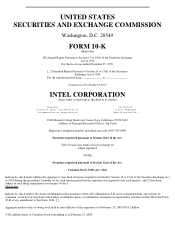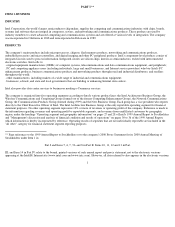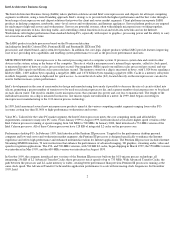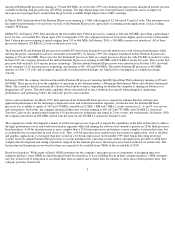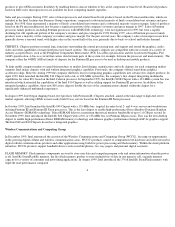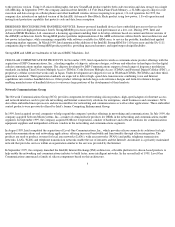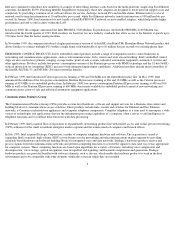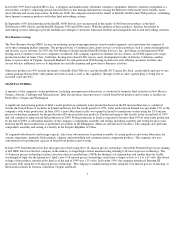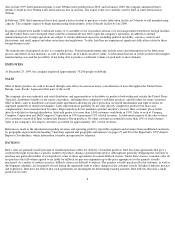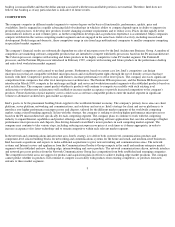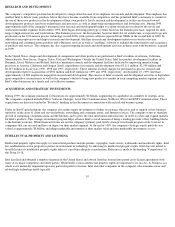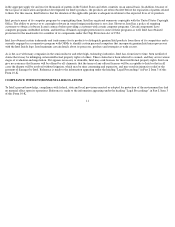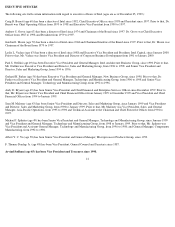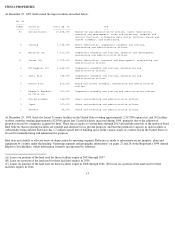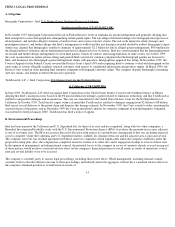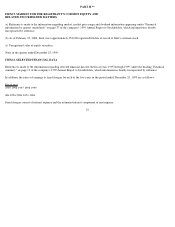Intel 1999 Annual Report Download - page 12
Download and view the complete annual report
Please find page 12 of the 1999 Intel annual report below. You can navigate through the pages in the report by either clicking on the pages listed below, or by using the keyword search tool below to find specific information within the annual report.backlog is noncancellable and that the dollar amount associated with the noncancellable portion is not material. Therefore, Intel does not
believe that backlog as of any particular date is indicative of future results.
COMPETITION
The company competes in different market segments to various degrees on the basis of functionality, performance, quality, price and
availability. Intel is engaged in a rapidly advancing field of technology in which its ability to compete depends upon its ability to improve its
products and processes, to develop new products to meet changing customer requirements and to reduce costs. Prices decline rapidly in the
semiconductor industry as unit volumes grow, as further competition develops and as production experience is accumulated. Many companies
compete with Intel in the various computing market segments and are engaged in the same basic fields of activity, including research and
development. Both foreign and domestic, these competitors range in size from large multinational companies to smaller companies competing
in specialized market segments.
The company's financial results are substantially dependent on sales of microprocessors by the Intel Architecture Business Group. A number of
competitors are marketing software-
compatible products that are intended to compete with Intel's processors based on the P6 microarchitecture.
The Celeron processor competes with existing and future products in the highly competitive value PC market segment. The Pentium II
processor, and the Pentium III processor introduced in February 1999, compete with existing and future products in the performance desktop
and entry-level workstation market segment.
Many of Intel's competitors are licensed to use Intel patents. Furthermore, based on current case law, Intel's competitors can design
microprocessors that are compatible with Intel microprocessors and avoid Intel patent rights through the use of foundry services that have
licenses with Intel. Competitors' products may add features, increase performance or sell at lower prices. The company also faces significant
competition from companies that offer rival microprocessor architectures. The Pentium II Xeon processor, and the Pentium III Xeon processor
introduced in March 1999, compete in the mid-range and high-
end server and workstation market segments with established products based on
rival architectures. The company cannot predict whether its products will continue to compete successfully with such existing rival
architectures or whether new architectures will establish or increase market acceptance or provide increased competition to the company's
products. Future distortion of price maturity curves could occur as software-compatible products enter the market segment in significant
volume or alternative architectures gain market acceptance.
Intel's goal is to be the preeminent building block supplier to the worldwide Internet economy. The company's primary focus areas are client
platform, server platform, networking and communications, and solutions and services. Intel's strategy for client and server platforms is to
introduce ever higher performance microprocessors and chipsets, tailored for the different market segments of the worldwide computing
market, using a tiered branding approach. In line with this strategy, the company is seeking to develop higher performance microprocessors
based on the P6 microarchitecture specifically for each computing segment. The company plans to continue to work with the computing
industry to expand Internet capabilities and product offerings, and develop compelling software applications that can take advantage of higher
performance microprocessors and chipsets, thus driving demand toward Intel's newer products in each computing market segment. The
company may continue to take various steps, including reducing microprocessor prices at such times as it deems appropriate, in order to
increase acceptance of its latest technology and to remain competitive within each relevant market segment.
In the network and communications infrastructure area, Intel's strategy is to deliver both system-level communications products and
component-level silicon building blocks for networking and communications systems for the home and small- and medium-sized businesses.
Intel has made acquisitions and expects to make additional acquisitions to grow new networking and communications areas. The network
systems and Internet servers and appliances from the Communications Products Group compete in the small and medium enterprise market
segments with established and new, leading-
edge, internetworking and server products. The network communications silicon, network interface
and network processor products from the Network Communications Group face competition from both established and emerging companies.
The competitors in these areas use aggressive product and acquisition plans in efforts to achieve leading-edge market positions. The company
cannot predict whether its products will continue to compete successfully with products from existing competitors, or products from new
entrants to these market segments.
9


